Olivier de Kersauson / Geronimo
A new duel between Kersauson and Peyron on the quest for the Trophy. On board the maxi-trimaran Geronimo, the skipper from Brittany and his ten crewmembers vied to steal the title from their rival from La Baule. Their most ferocious opponents were present to challenge them: storms, contrary winds and “boat-breaking” swells. The elements were against him, but Olivier de Kersauson persisted with his obsession with the Jules Verne Trophy.
“We can’t get through there, we can’t get through the swells and wind, it’s the sort of situation where we’ll end up upside down… For four days now we’ve stopped racing, we’ve reached the point of just surviving… If things don’t improve, the only thing we can do is to flee north. And never go round Cape Horn.”
29 March, 32nd day at sea. 51° South, 179° West. A southerly wind blowing at 40 knots (74km/h) at the gates of the Pacific. Sailing with a mast only, Geronimo was bolting at 27 knots. Rough, icy sea, straight from the ice cap, was crashing at 35 knots (64km/h) against the trimaran’s floats.
A good captain doesn’t rant. Over the radio, Kersauson’s words calmly conveyed the drama that was being played out on Geronimo: “At this time of the year, in these seas, we’re not in the North Atlantic where people are around. If we keep going ahead, we’re dead.”
Apache warrior
It took a warrior to see this epic to the end. To bring the men home. Geronimo was the first new-generation maxi-trimaran. The prototype measuring nearly 34 meters was designed to slip along downwind, to maintain its speed when winds were light, and to resist boat-breaking seas. Olivier de Kersauson’s multihull had already gained experience on three attempts at the Jules Verne, including a full tour of the world in 2003. On 25 February 2004, it was caught up in the bitterest battle of its existence.
The record to wipe out, the one set by Bruno Peyron in 2002, was 64 days, 8 hours, 37 minutes and 40 seconds.
On board, eleven sailors(1)(1)The Geronimo crew: Olivier de Kersauson (skipper), Yves Pouillaude and Didier Ragot (seconds), Pierre Corriveaud, Franck Ferey, Pascal Blouin, Xavier Douin, Antoire Deru, Armand Coursaudon, Philippe Laot, Xavier Briault (crew members). had been in training for two years. Between them, they had notched up 18 circumnavigations.
The signs were not favorable. Setting off a first time on 8 February, Geronimo had made a premature return to Brest on 20 February. Two gennakers had given way. It was impossible to set a new record without this sail, a hybrid of a spinnaker and a genoa, the main “engine” of the boat in the trade winds and in calm zones.
With its sails repaired, Geronimo crossed the starting line again on 25 February 2004, at 23 hours, 17 minutes and 40 seconds GMT.
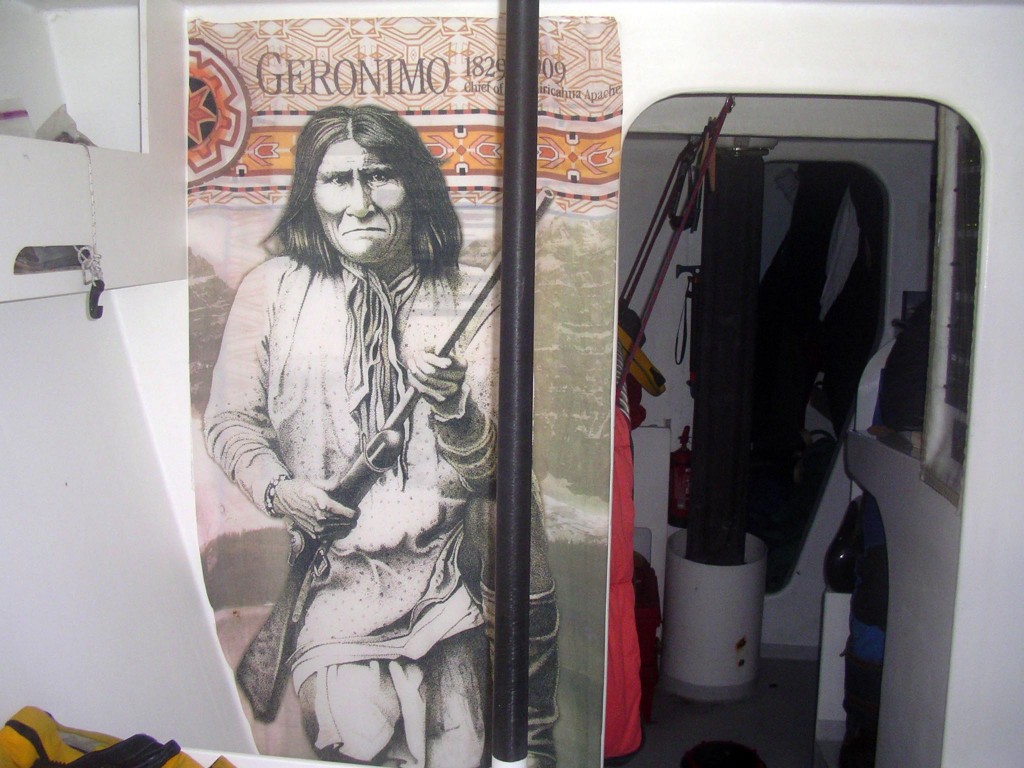
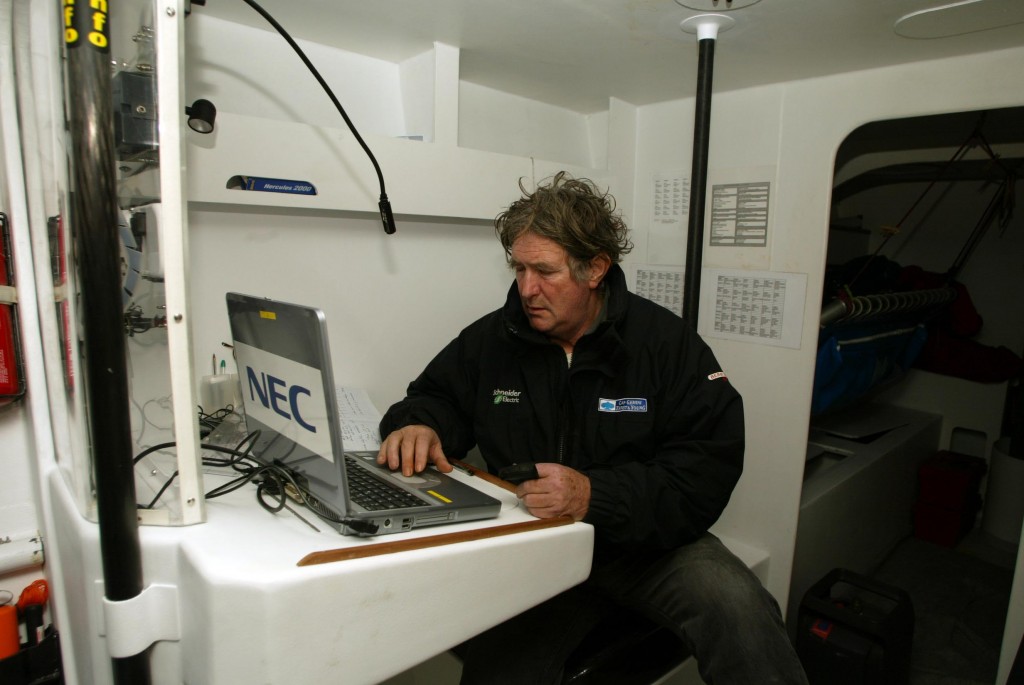 Archives Rivacom
Archives Rivacom
Hazards
A few hours later, Orange II, Bruno Peyron’s catamaran, set out to beat its own record. “Kersau” was a bit put out. His rival’s multihull was 20 % bigger, and would probably sail faster in equal conditions. “It’s always more fun to have someone on water at the same time as you,” said the skipper from Brittany, resigning himself to the situation. “We’re going to make a nice trip around the world, we’re glad to be going.”
“We’ve been waiting for this for a few years,” added Peyron. “For the duel to take place. It’s one of life’s hazards. We’re going to settle our score on water…”
Another challenger was casting off at the same time as the Apache warrior at the start of February: Cheyenne. Another hazard? This was the name given by billionaire lover of extreme sports Steve Fossett to his giant catamaran (37.90 meter). The American refused to pay the compulsory 30,000 euros for registering his round-the-world speed record attempt via the three capes as required by the Jules Verne Trophy. He was competing unofficially(2)(2)At that time, Steve Fossett considered the membership fee (30,000 euros) payable to the Tour du Monde en 80 Jours association – mandatory for registering an attempt at the Jules Verne Trophy – too high and unjustified. As the association benefitted from no grants for its operation aside from membership contributions, it did not wish to allow an exception or to change a rule that all Jules Verne Trophy challengers had accepted, ever since its inception. but following the same itinerary. He was already up to his 20th day at sea, at 48° South.
24 hours of joy
The first 24 hours of sailing were ideal: 29 knot peaks for Geronimo that widened its gap with its supposedly faster opponent.
The wind system deteriorated as of the second day. The Azores High, positioned very far east, slowed the boat. Kersauson took solace by anticipating the next leg that he was very familiar with: “I’m impatient to go back to the real trade-wind systems to see how we go.”
Before reaching the hoped-for trade winds, Geronimo had to face the Doldrums that were particularly widely spread. This zone of unstable winds around the equator grew day by day and blocked the Atlantic from east to west. There was no hint of fun on the horizon. All the more as on the sixth day of sailing, the crew learned that Orange II’s fifteen-member crew had given up, as a result of damage. The duel with the record-holder would be continuing virtually, without the spice of a real race.
Detour
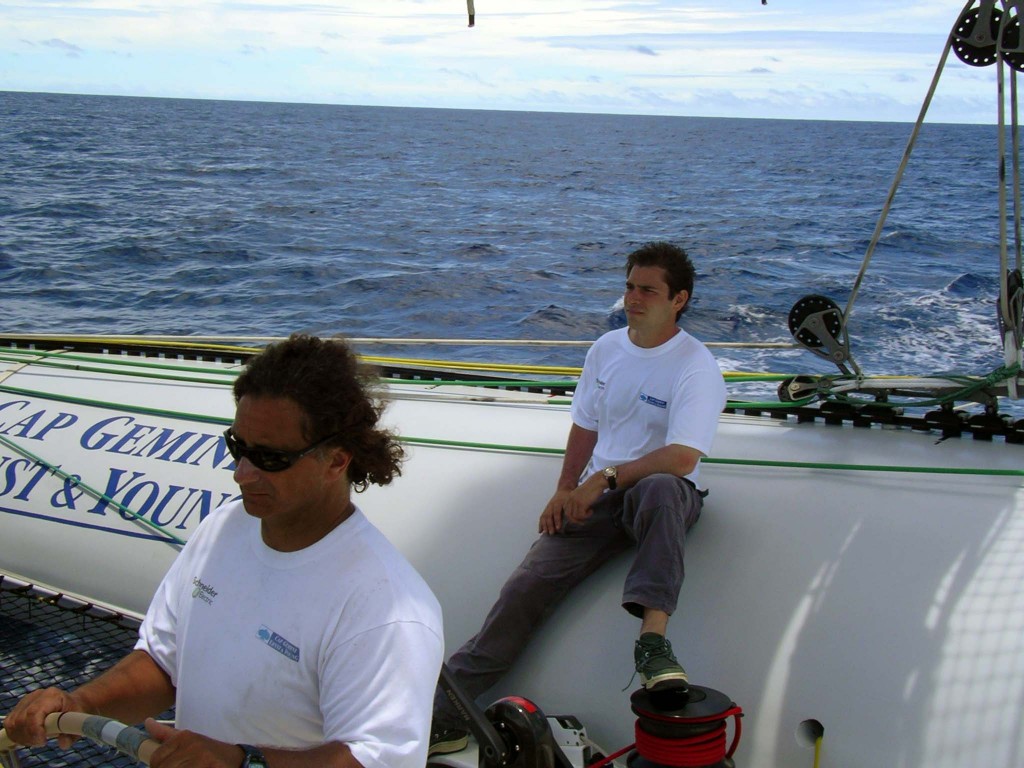 Didier Ragot and Xavier Douin. Archives Rivacom
Didier Ragot and Xavier Douin. Archives Rivacom
Geronimo crossed the equator on 4 March, 7 days, 22 hours and 23 minutes after its departure, exactly matching Orange’s time in 2002. Flushed out of the calmness of the Intertropical Convergence Zone(3)(3)Intertropical Convergence Zone of Doldrums. where it had been trapped, the maxi-trimaran reestablished a daily average surpassing 20 knots. “We’re not losing time but we need to gain some!” commented Olivier de Kersauson.
A new obstacle in the Atlantic gymkhana lurked: Saint Helena’s High, very far to the south, stretching from Argentina to Africa, that the crew approached slowly, sluglike. The Geronimo crew had to broadly skirt this calm zone by the west, reaching the forties in the south, before finally turning off due east, towards the Cape of Good Hope. A 50-degree diversion compared with the ideal route, thankfully compensated by fine surfing conditions at over 25 knots, with up to 608 miles covered over 24 hours.
At 42° south, on the 17th day at sea, Geronimo zigzagged through a narrow corridor, between an anticyclone in the north and ice in the south. The longitude of the Cape of Good Hope was crossed on the night of 14 March, one day ahead of the record(4)(4)17 days, 22 hours and 58 minutes of sailing between Ushant and the Cape of Good Hope, compared with the 18 days, 18 hours and 40 minutes recorded by Orange in 2002..
Russian roulette
Facing northwesterly winds, Geronimo had to bend its route towards the Prince Edward and Crozet Islands, directly heading towards the Kerguelen Islands. “I would have preferred heading there 7 to 8 degrees further away,” regretted the skipper from Brittany over the radio on 15 March. “But we’ll live with it, we have a good radar. I hope that the fog will lift a bit.” As of their entry in the Indian Ocean, at an average of 18 knots, the crew was plunged in mist. “Fog is romantic, but after five or six hours, it begins to be a pain.” The thick layer finally evaporated on 17 March after three days of sailing with instruments, eyes fixed on the radar to check on signs of invisible icebergs(5)(5)The radar allows detection of iceberg masses, but not of the blocks of ice that detach from them. Due to one of these blocks of ice ripping off the float of his trimaran Charal, Olivier de Kersauson had been forced to abandon his first attempt at the circumnavigation record in 1993.. The air temperatures plummeted to below zero. Speed, fog and cold exhausted the men. “It’s so terrifying when we know that the ice is just nearby, when we have the feeling that we’re playing Russian roulette,” was the way that Kersauson summed it up. “This stress is becoming really hard to bear.”
Geronimo persevered. The advance on Orange’s record reached 800 miles.
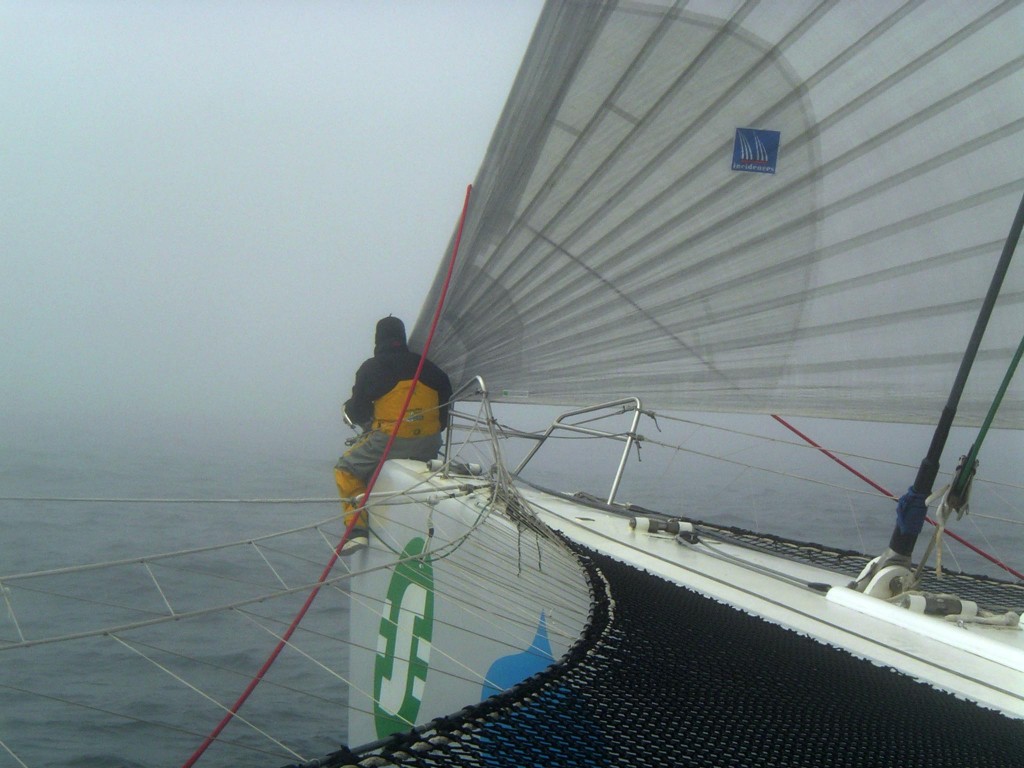 Archives Rivacom
Archives Rivacom
The Indian Ocean, so dreaded by the skipper from Brittany, offered a few hours of respite and a little gliding for the crew. Geronimo swallowed up the miles, hurrying to Australia. But to catch up with a more advantageous weather system, the trimaran tried to gain speed from the wind that had been pushing it along since Africa…And landed in dead calm on 23 March. Between the Roaring Forties and the Furious Fifties, the team crossed the longitude of Cape Leeuwin two days and 20 hours ahead of the holder of the Jules Verne Trophy(6)(6)Ushant-Cape Leeuwin in 26 days, 11 hours and 33 minutes compared with 29 days, 7 hours and 22 minutes for Orange in 2002.… With wind at a measly nine knots.
Survival
The depression that crew wanted to overtake ended up helping out the multihull as soon as it entered the Pacific. Geronimo’s average speed no longer went under 20 knots. The crew, worn out by three days of struggle in the light wind, suddenly rediscovered speed and icy wind. Kersauson was wary: “We’re between dead calm and storms, with wind jumping from 30 to 12 knots. We’re between two depressions, with a tropical cyclone above.”
Storms met the skipper and his men at 53° South and 158 ° East. Pursued by 50 knots of wind on a heavy, rocky sea, the eleven on board Geronimo hoped to find more favorable conditions for speed. Destination northeast.
On a radio message given on 29 March, Kersauson didn’t hide his doubts about the Jules Verne Trophy: “The sea isn’t very high: waves are seven meters high, but they’re incredibly powerful. The other night we surfed along barepoled, at 27 knots, it was like a killing game. What we did there had nothing to do with the competition, it was athletic survival. (…) It’s really tough. I don’t know where we’ll end up with this. But we haven’t been racing for four days. For four days now, it’s been extreme sailing…”
On 1 April, Kersauson glimpsed an opportunity to get back in the saddle: a westerly flow at 55° South. On 2 April, to deliver his daily message, the skipper lay down in his oilskin at the bottom of the boat: “Right now, we have 58 knots of wind according to the anemometer, we’ve got three reefs and the storm sail is up. In my eight world tours, I’ve never seen such a south. In fact, if I’d already seen one like it, I’d never have come back!”
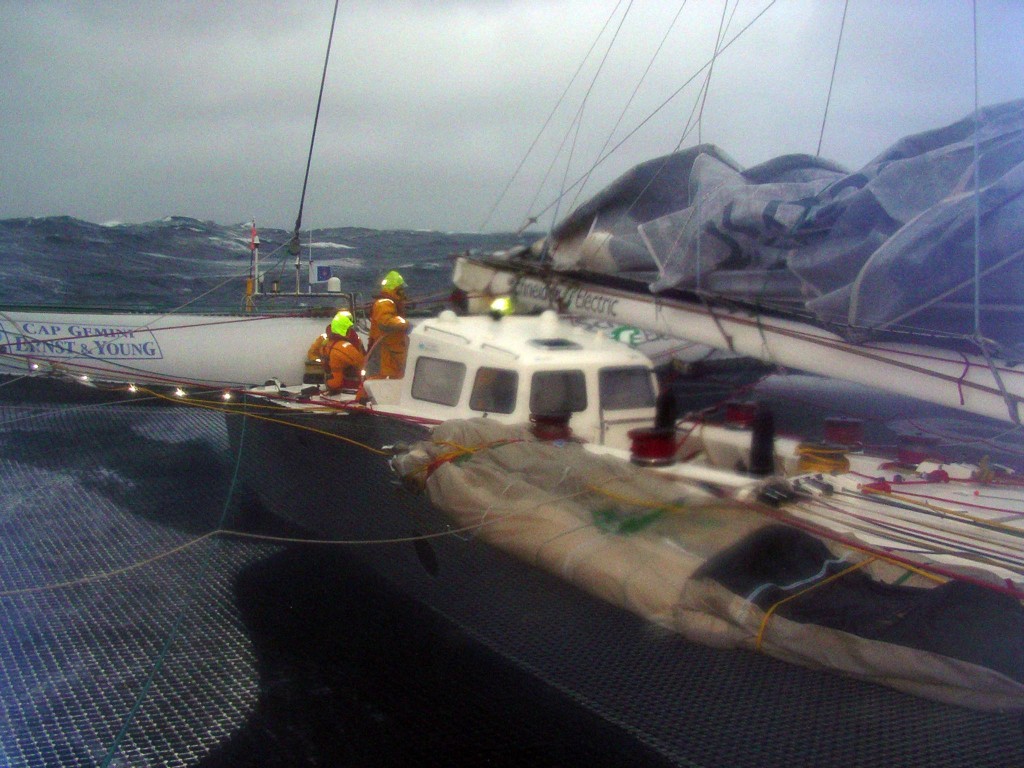 Archives Rivacom
Archives Rivacom
Backwards
On 6 April, veering close to 59° South, Geronimo waited for the right moment to round the Horn. The conditions for going around the cape were more appropriate for a boat sailing from the opposite direction. 20 knots of wind swung slowly from the east to the south. The crew waited for the depression that would cast it outside the Pacific and into the Atlantic.
On 7 April, Geronimo finally rounded the mythical cape, at 17 hours 45 minutes, after 41 days, 16 hours and 27 minutes – in other words, a result that bettered that of the Jules Verne titleholder by 10 hours… But that was 48 hours more than the new champion.
Cheyenne arrived at Ushant on 5 April, after 58 days, 9 hours, 32 minutes and 45 seconds of sailing. It was official: even if he hadn’t won the Jules Verne(7)(7)While Cheyenne was climbing back up the Atlantic, fairly sure that it would beat the Jules Verne Trophy record, Steve Fossett’s land team had contacted the Tour du Monde en 80 Jours association. It wished, a posteriori, to register the American skipper’s attempt in the Trophy and offered to pay the fees that Fossett had considered inappropriate when he had left Brest. The association declined the offer and refused the registration. The very simple rules of the Jules Verne Trophy demand that a challenger sign up at least three months before an anticipated departure.
Fossett could no longer make any claims on the title as he had refused to comply with the rules defining the conditions for winning it. Following the vision of its founders and its successive defenders, the Jules Verne Trophy had to remain the object of a harshly fought competition and not be a reward handed over for a successful circumnavigation.
, Steve Fossett now held the absolute speed record for circumnavigation, without stops and with a crew.
Close-hauled without a solent
The route now led due north, west of the Falklands. Kersauson’s crew was impatient to return to Brest and to leave the hostile seas of this world tour. After a month of violence, the eleven on the Geronimo, dazed, were forced to tack to go back up the Atlantic by the shortest route. The solent jib that ensured a minimum of speed when sailing close-hauled with little wind, died for a second time.
Followed by an anticyclone, on the 49th day, with a staysail and a full mainsail, Geronimo finally latched onto some weak trade winds. Olivier de Kersauson kept up his advance on Bruno Peyron’s performance, but failing a miraculous break in the weather, he knew that Steve Fossett would keep his absolute record.
Haggard
Wind was back on day 52. A few hours of slipping along at an average of 20 knots in the trade winds reminded the crew of how, on this trip, moments of grace were rare… and all too brief.
Geronimo soon slowed at the entrance of a very broad and mobile Doldrums zone.
The equator was crossed on 20 April, after 54 days, 4 hours and 49 minutes at sea: a little less than a day behind Orange in 2002(8)(8)Ushant-Equator (return) in 53 days, 4 hours and 49 minutes..
“They’ve got blank expressions, I don’t know if it’s fatigue, sadness or weariness,” confided Kersauson on 21 April even though his crew managed to reacquaint their trimaran with the northern hemisphere trade winds.
The boat made up its lag behind the record-holder the next day, but still, it was flagging. The front left outrigger was suffering from partial delamination – damage that was impossible to fix at sea.
Deliverance
The route home was no cinch for Kersauson’s men. To hope to carry off the Jules Verne Trophy, they had to cross an anticyclone, sail close-hauled, and cross the arrival line on the British side after a long detour to the south of Ireland. A feat never seen, with a solent and an outrigger in shreds.
Geronimo went over the finishing line after being at sea for 63 days, 13 hours, 59 minutes and 46 seconds, at 15 hours 17 minutes, French time. The record had been beaten – just: by half a day.
The first homage paid by the new holder of the Jules Verne Trophy was to his vessel. “When we see the blows we took, we know the boat is good, it gives us back to us the love we show it, it didn’t betray us, it has talent, I can’t explain how it held on! Once we went over the finishing line, I saw the men kiss it. Never again will we venture to the Pacific during winter. And I’m adamant.”
Geronimo would not go on the Jules Verne circuit again. On 29 April 2004, the ever-feisty Viscount de Kersauson signed his ninth and last attempt at the Trophy(9)(9)Between 1993 and 2004, only five records were set by three different navigators out of a total of 18 attempts.: “Finally, it’s done, I feel like a guy who’s been hanging by his balls for a month and who’s just been taken off the hook.”
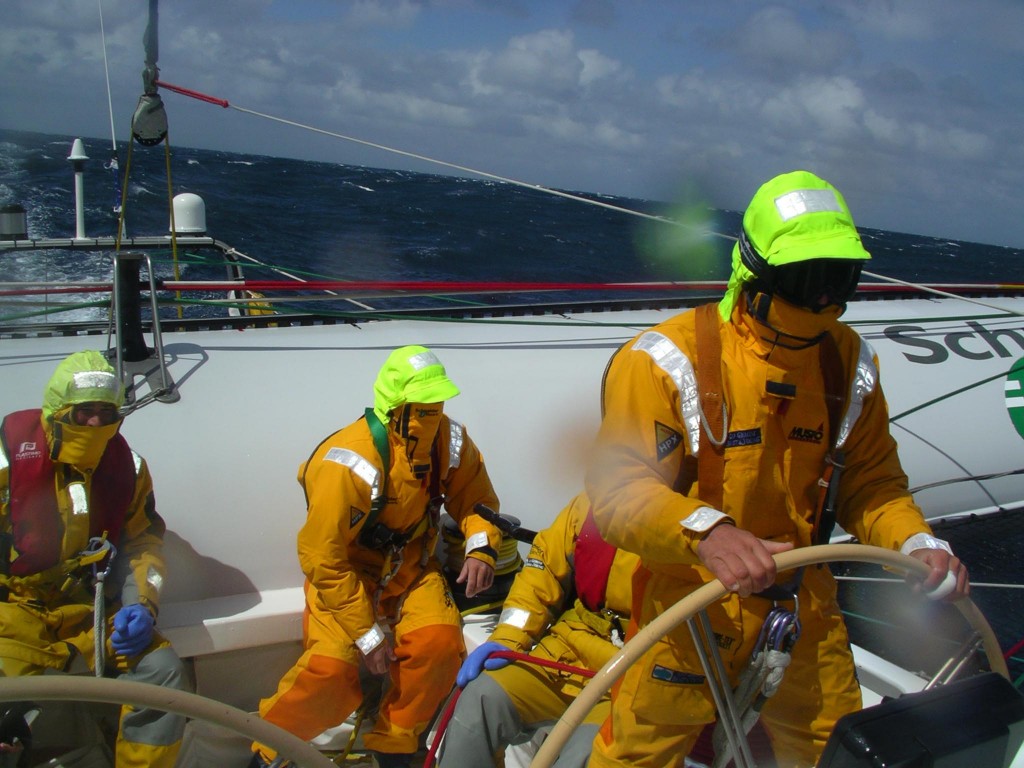 Archives Rivacom
Archives Rivacom
13h | 59min | 46s
2004
2004-03-01
23 h 17 TU
15°48 N
24°06 W
20
LOADING...
2004-03-04
23 h 17 TU
00°10 N
28°07 W
10
LOADING...
2004-03-11
23 h 17 TU
42°25 S
11°17 W
25
LOADING...
2004-03-23
23 h 18 GMT
50°36 S
121°40 E
14
LOADING...
2004-03-16
23 h 18 GMT
48°46 S
43°56 E
21
LOADING...
2004-03-28
23 h 18 GMT
51°365 S
169°04 W
18

LOADING...
2004-03-31
23 h 18 GMT
51°37 S
144°20 W
20
LOADING...
2004-04-08
23 h 17 GMT
48°41 S
59°58 W
18
LOADING...
2004-04-26
23 h 17
43°20 N
29°03 W
23
LOADING...
2004-04-28
15 h 07 GMT
49°05 N
16°05 W
13
LOADING...

